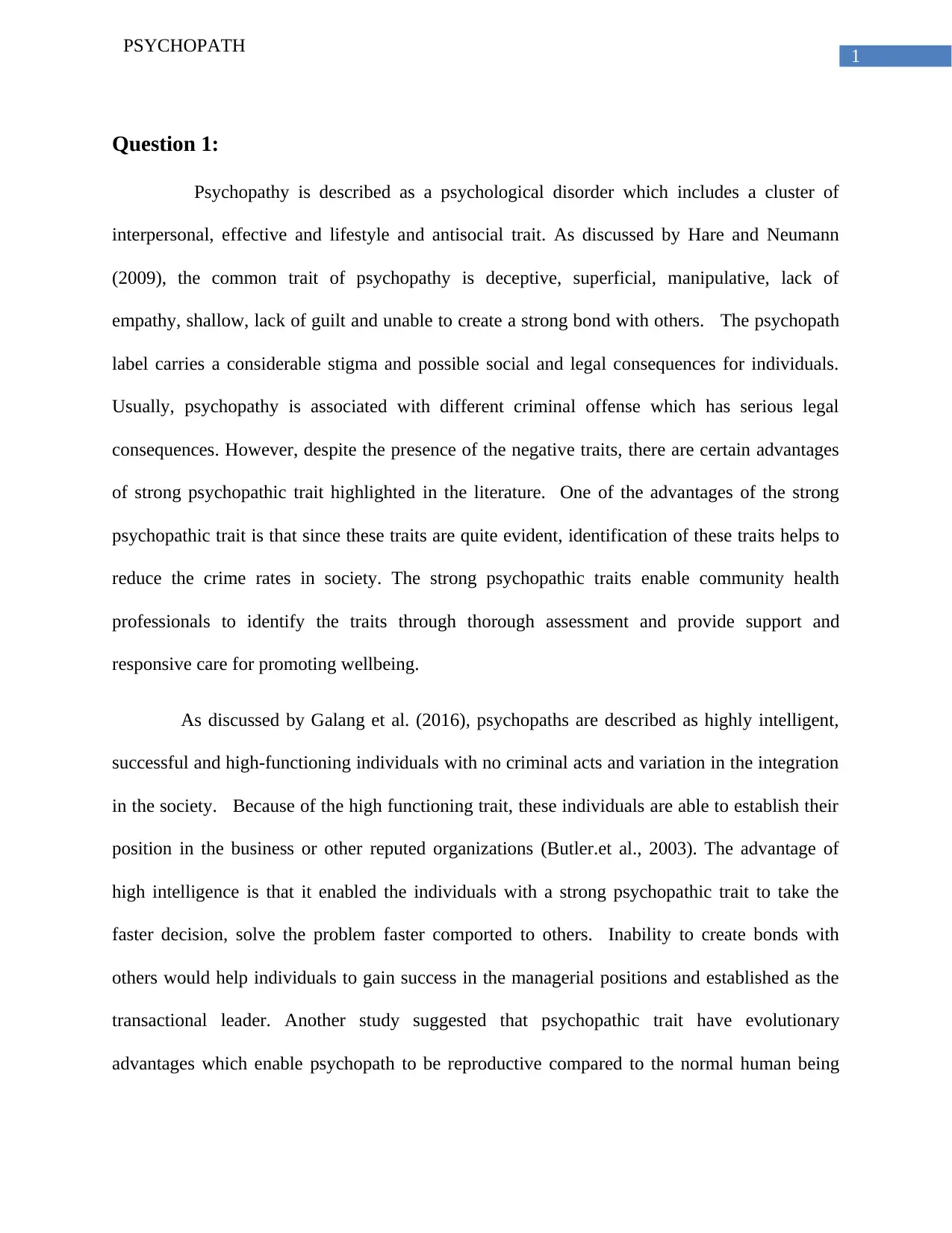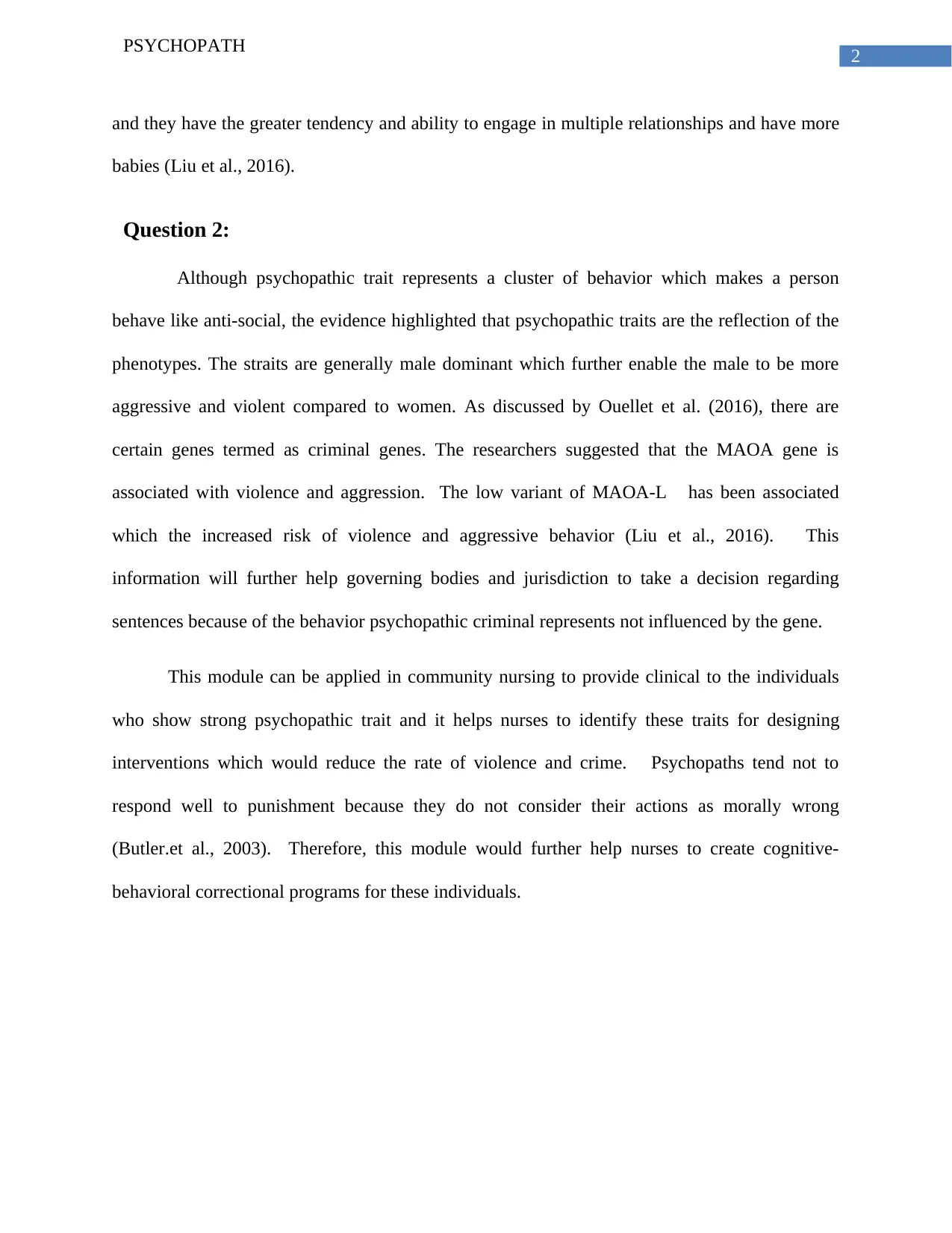University Psychology Essay: Psychopathy, Genetics, and Implications
VerifiedAdded on 2023/01/18
|4
|809
|32
Essay
AI Summary
This essay delves into the psychological disorder of psychopathy, examining its interpersonal, affective, and lifestyle traits as defined by Hare and Neumann. It explores the advantages of psychopathic traits, such as enhanced intelligence and decision-making abilities, and their potential benefits in various professional settings. The essay also investigates the genetic influences on psychopathy, specifically the role of the MAOA gene in aggression and violence, and discusses the implications for community nursing and the development of cognitive-behavioral programs. The research references studies by Galang et al., Liu et al., and Ouellet et al., providing a comprehensive overview of the subject matter.

Running head: PSYCHOPATH
Name of the student
Name of the university
Author note:
Name of the student
Name of the university
Author note:
Paraphrase This Document
Need a fresh take? Get an instant paraphrase of this document with our AI Paraphraser

1
PSYCHOPATH
Question 1:
Psychopathy is described as a psychological disorder which includes a cluster of
interpersonal, effective and lifestyle and antisocial trait. As discussed by Hare and Neumann
(2009), the common trait of psychopathy is deceptive, superficial, manipulative, lack of
empathy, shallow, lack of guilt and unable to create a strong bond with others. The psychopath
label carries a considerable stigma and possible social and legal consequences for individuals.
Usually, psychopathy is associated with different criminal offense which has serious legal
consequences. However, despite the presence of the negative traits, there are certain advantages
of strong psychopathic trait highlighted in the literature. One of the advantages of the strong
psychopathic trait is that since these traits are quite evident, identification of these traits helps to
reduce the crime rates in society. The strong psychopathic traits enable community health
professionals to identify the traits through thorough assessment and provide support and
responsive care for promoting wellbeing.
As discussed by Galang et al. (2016), psychopaths are described as highly intelligent,
successful and high-functioning individuals with no criminal acts and variation in the integration
in the society. Because of the high functioning trait, these individuals are able to establish their
position in the business or other reputed organizations (Butler.et al., 2003). The advantage of
high intelligence is that it enabled the individuals with a strong psychopathic trait to take the
faster decision, solve the problem faster comported to others. Inability to create bonds with
others would help individuals to gain success in the managerial positions and established as the
transactional leader. Another study suggested that psychopathic trait have evolutionary
advantages which enable psychopath to be reproductive compared to the normal human being
PSYCHOPATH
Question 1:
Psychopathy is described as a psychological disorder which includes a cluster of
interpersonal, effective and lifestyle and antisocial trait. As discussed by Hare and Neumann
(2009), the common trait of psychopathy is deceptive, superficial, manipulative, lack of
empathy, shallow, lack of guilt and unable to create a strong bond with others. The psychopath
label carries a considerable stigma and possible social and legal consequences for individuals.
Usually, psychopathy is associated with different criminal offense which has serious legal
consequences. However, despite the presence of the negative traits, there are certain advantages
of strong psychopathic trait highlighted in the literature. One of the advantages of the strong
psychopathic trait is that since these traits are quite evident, identification of these traits helps to
reduce the crime rates in society. The strong psychopathic traits enable community health
professionals to identify the traits through thorough assessment and provide support and
responsive care for promoting wellbeing.
As discussed by Galang et al. (2016), psychopaths are described as highly intelligent,
successful and high-functioning individuals with no criminal acts and variation in the integration
in the society. Because of the high functioning trait, these individuals are able to establish their
position in the business or other reputed organizations (Butler.et al., 2003). The advantage of
high intelligence is that it enabled the individuals with a strong psychopathic trait to take the
faster decision, solve the problem faster comported to others. Inability to create bonds with
others would help individuals to gain success in the managerial positions and established as the
transactional leader. Another study suggested that psychopathic trait have evolutionary
advantages which enable psychopath to be reproductive compared to the normal human being

2
PSYCHOPATH
and they have the greater tendency and ability to engage in multiple relationships and have more
babies (Liu et al., 2016).
Question 2:
Although psychopathic trait represents a cluster of behavior which makes a person
behave like anti-social, the evidence highlighted that psychopathic traits are the reflection of the
phenotypes. The straits are generally male dominant which further enable the male to be more
aggressive and violent compared to women. As discussed by Ouellet et al. (2016), there are
certain genes termed as criminal genes. The researchers suggested that the MAOA gene is
associated with violence and aggression. The low variant of MAOA-L has been associated
which the increased risk of violence and aggressive behavior (Liu et al., 2016). This
information will further help governing bodies and jurisdiction to take a decision regarding
sentences because of the behavior psychopathic criminal represents not influenced by the gene.
This module can be applied in community nursing to provide clinical to the individuals
who show strong psychopathic trait and it helps nurses to identify these traits for designing
interventions which would reduce the rate of violence and crime. Psychopaths tend not to
respond well to punishment because they do not consider their actions as morally wrong
(Butler.et al., 2003). Therefore, this module would further help nurses to create cognitive-
behavioral correctional programs for these individuals.
PSYCHOPATH
and they have the greater tendency and ability to engage in multiple relationships and have more
babies (Liu et al., 2016).
Question 2:
Although psychopathic trait represents a cluster of behavior which makes a person
behave like anti-social, the evidence highlighted that psychopathic traits are the reflection of the
phenotypes. The straits are generally male dominant which further enable the male to be more
aggressive and violent compared to women. As discussed by Ouellet et al. (2016), there are
certain genes termed as criminal genes. The researchers suggested that the MAOA gene is
associated with violence and aggression. The low variant of MAOA-L has been associated
which the increased risk of violence and aggressive behavior (Liu et al., 2016). This
information will further help governing bodies and jurisdiction to take a decision regarding
sentences because of the behavior psychopathic criminal represents not influenced by the gene.
This module can be applied in community nursing to provide clinical to the individuals
who show strong psychopathic trait and it helps nurses to identify these traits for designing
interventions which would reduce the rate of violence and crime. Psychopaths tend not to
respond well to punishment because they do not consider their actions as morally wrong
(Butler.et al., 2003). Therefore, this module would further help nurses to create cognitive-
behavioral correctional programs for these individuals.
⊘ This is a preview!⊘
Do you want full access?
Subscribe today to unlock all pages.

Trusted by 1+ million students worldwide

3
PSYCHOPATH
References:
Galang, A. J. R., Castelo, V. L. C., Santos III, L. C., Perlas, C. M. C., & Angeles, M. A. B.
(2016). Investigating the prosocial psychopath model of the creative personality:
Evidence from traits and psychophysiology. Personality and Individual Differences, 100,
28-36. Retrieved from: https://daneshyari.com/article/preview/889621.pdf
Liu, Z., Huang, L., Luo, X. J., Wu, L., & Li, M. (2016). MAOA variants and genetic
susceptibility to major psychiatric disorders. Molecular neurobiology, 53(7), 4319-4327.
Retrieved from: http://or.nsfc.gov.cn/bitstream/00001903-
5/240705/1/1000013806449.pdf
Ouellet-Morin, I., Côté, S. M., Vitaro, F., Hébert, M., Carbonneau, R., Lacourse, E., ... &
Tremblay, R. E. (2016). Effects of the MAOA gene and levels of exposure to violence on
antisocial outcomes. The British Journal of Psychiatry, 208(1), 42-48. doi:
10.1192/bjp.bp.114.162081
Hare, R. P., & Neumann, C. P. (2009). Psychopathy: Assessment and Forensic Implications.
Canadian Journal of Psychiatry, 54(12), 791. Retrieved from
http://encore.newcastle.edu.au/iii/encore/record/C__Rb3132278?
lang=eng#.Vr1tq5N94UE.
PSYCHOPATH
References:
Galang, A. J. R., Castelo, V. L. C., Santos III, L. C., Perlas, C. M. C., & Angeles, M. A. B.
(2016). Investigating the prosocial psychopath model of the creative personality:
Evidence from traits and psychophysiology. Personality and Individual Differences, 100,
28-36. Retrieved from: https://daneshyari.com/article/preview/889621.pdf
Liu, Z., Huang, L., Luo, X. J., Wu, L., & Li, M. (2016). MAOA variants and genetic
susceptibility to major psychiatric disorders. Molecular neurobiology, 53(7), 4319-4327.
Retrieved from: http://or.nsfc.gov.cn/bitstream/00001903-
5/240705/1/1000013806449.pdf
Ouellet-Morin, I., Côté, S. M., Vitaro, F., Hébert, M., Carbonneau, R., Lacourse, E., ... &
Tremblay, R. E. (2016). Effects of the MAOA gene and levels of exposure to violence on
antisocial outcomes. The British Journal of Psychiatry, 208(1), 42-48. doi:
10.1192/bjp.bp.114.162081
Hare, R. P., & Neumann, C. P. (2009). Psychopathy: Assessment and Forensic Implications.
Canadian Journal of Psychiatry, 54(12), 791. Retrieved from
http://encore.newcastle.edu.au/iii/encore/record/C__Rb3132278?
lang=eng#.Vr1tq5N94UE.
1 out of 4
Related Documents
Your All-in-One AI-Powered Toolkit for Academic Success.
+13062052269
info@desklib.com
Available 24*7 on WhatsApp / Email
![[object Object]](/_next/static/media/star-bottom.7253800d.svg)
Unlock your academic potential
Copyright © 2020–2025 A2Z Services. All Rights Reserved. Developed and managed by ZUCOL.



